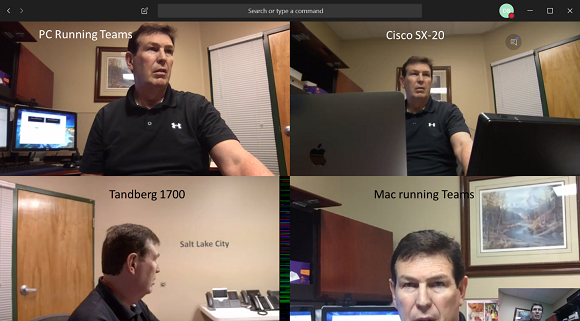One of the challenges facing organizations using Microsoft Skype for Business as delivered through Office 365 is Microsoft’s relentless pressure to migrate to Microsoft Teams. Even as it released Skype for Business Server 2019 into general availability earlier this month, Microsoft positioned this release as “mostly … about making your transition to hybrid easier.” The implication is that although organizations can still use Skype for Business in an on-premises deployment, some functional elements that used to be entirely on premises are going to the cloud. These include voicemail handling and call quality data, for example.
Among other issues delaying some organizations from planning Teams migrations has been the absence of one critical collaboration capability: the ability to include group video endpoints in a Teams meeting. With Skype for Business, a variety of mechanisms allow group video endpoints to interoperate with and join Skype for Business meetings. This has been possible because Microsoft made its Skype for Business video specification public, and any vendor that wanted to go to the trouble of developing gateways to that spec had Microsoft’s blessing -- and a number of companies did so.
However, video interoperability is different with Teams, as I’ve discussed in my previous article, “Integrating Third-Party Voice & Video with Microsoft Teams.” Microsoft has changed how video works within Teams and hasn’t made this spec publicly available, believing that controlling the user experience is too important. This means Microsoft wants to have update control over Teams’ cloud components as well as the desktop and mobile Teams clients. By controlling both the cloud capabilities and the clients that access those capabilities, Microsoft feels it will be able to deliver the best possible collaboration experience for users. The use of third-party video devices breaks this paradigm, as Microsoft has no control over how these video devices operate.
Nevertheless, and despite its desire to control the end-to-end Teams user experience, Microsoft has permitted three of its partners to prepare video gateway services that will enable group video endpoints to connect into Teams meetings. The partners are BlueJeans, Pexip, and Polycom, and their services will all be available this quarter. While similar in many respects, there are some differences.</p><p>
KelCor recently had the opportunity to deploy and beta test the BlueJeans Gateway for Microsoft Teams in its lab using our Office 365 subscription, which includes Teams. Quite frankly, the experience using this video gateway with Teams was absolutely fantastic!
The process for deploying the gateway couldn’t have been simpler. It required only two steps:
- Accepting the terms for using the gateway, which gives permissions to the gateway application to access the Exchange calendar, media streams, and join in one-on-one and group Teams calls
- Execution of eight lines of PowerShell code that do the actual provisioning of the BlueJeans Gateway
KelCor doesn’t have much PowerShell expertise, but even for us, executing these commands was really easy. BlueJeans sent them to us, and all we had to do was copy and paste them into the PowerShell command window. It took less than 10 minutes to provision the gateway. (Note: After executing these commands, it actually took a while for Microsoft to push the service through the Azure cloud, so be prepared for a bit of delay from the time the service is provisioned using PowerShell until it is actually available for use.)
Our experience using BlueJeans Gateway with Teams was excellent. We used two group video endpoints -- a Cisco SX-20 and an old Tandberg 1700 personal unit -- to connect into Teams meetings. Both joined the Teams meetings the first time and every time we tried them.
As part of a BlueJeans Gateway deployment, an organization receives a unique BlueJeans Gateway numeric identifier. This identifier, a sequence of nine numbers, is used in the dialing string when connecting into the Teams meeting. The format for dialing is as follows:
<organization identifier>.<Teams conference ID>@ teams.bjn.vc.
The dialing string can be made even simpler by using the DNS address for the BlueJeans Gateway. Thus, for the meeting above, the dialing string became:
[email protected]
We found it much easier to dial into meetings using this format because it eliminated the need to dial alphanumeric characters from a handheld remote. We only had to dial numbers, the periods, and the ampersand.
Screen sharing from a Teams client appears on the group video conferencing unit as you’d expect. The page below is a screen shot taken from a Cisco SX-20 in a Teams meeting in which the PC is sharing content.
Finally, we tried out the BlueJeans “One Touch Join” capability, which enables group video endpoints to join a meeting by pressing one button on the handheld remote or the control panel paired with a particular video unit. One Touch Join worked flawlessly to connect our endpoints into Teams meetings by pressing a single button.
As someone who likes to use video when meeting with others, I’m very pleased that gateway functionality is now available to connect group video endpoints with Teams. I can’t yet comment on how the other gateway services work, but I can certify that BlueJeans Gateway for Microsoft Teams works remarkably well.
Finally, those with conference rooms sporting group video endpoints can meet and fully participate in meetings hosted using Microsoft Teams!











